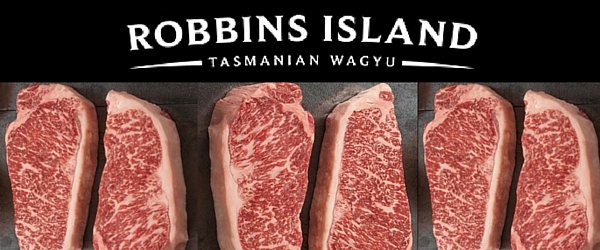1. News & Events, Uncategorized
ROBBINS ISLAND WEEKEND OF WAGYU
Robbins Island Weekend of Wagyu
Our weekend of Robbins Island Wagyu starts this Friday 11.03.16
Various premium cuts available.
For pricing and cut availability please contact the store direct. Ph 07 3366 2912
MUST SEE – CLICK HERE TO WATCH AUSTRALIAN LANDLINE’S RECENT STORY ON ONE OF AUSTRALIA’S MOST UNIQUE CATTLE MUSTERS.
THE ROBBINS ISLAND STORY
Fourth generation cattle farmers John, Keith, Alex and Chauncey Hammond have been breeding wagyu on Robbins Island since the early 1990’s.
During the iconic seasonal musters , bands of horsemen swim the cattle through saltwater channels at low tide to move them peacefully between grazing areas.
Situated on the north western tip of Tasmania, the island has a temperate climate, clean air and a pristine coastal environment.
THE BREED
The Robbins Island Wagyu program started in 1993 with progeny from Michifuku, one of the most famous Tajima sires.
Michifuku and his father Monjiro are renowned throughout the world for their sort after prize winning genes and high marbling characteristics.
When combined with Hammond families’ expertise in farming, the pristine environment and unique feed ration, Robbins Island Wagyu is one of the truly unique Wagyu products on the market.
In Japanese, the concept of WA 和 from WAGYU translates to balance or peace. From Robbins Island, Tasmania, a unique taste – in harmony with nature.
THE DIFFERENCE
Robbins Island cattle are retained on pasture for at least two years before moving to supplemental grain finishing for consistency of marbling.
The feed ration has been created with the animal’s natural diet in mind, incorporating a high ratio of grass fodder and kelp seaweed extract from nearby King Island to reflect the local flora.
The product is packaged as being from either ‘Spring’ or ‘Autumn’ progeny in order to highlight seasonal variations in nutrition and climate.
In addition, the herd has been selectively bred to carry the elusive ‘soft fat’ gene, traditionally sort after by the Japanese for its lower melting points and buttery mouth feel.

